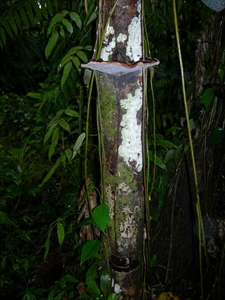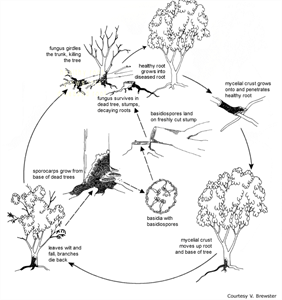Brown root rot
Pacific Pests, Pathogens, Weeds & Pesticides - Online edition
Pacific Pests, Pathogens, Weeds & Pesticides
Cocoa brown root rot (003)
Phellinus noxius
Asia, Africa, Central America, the Caribbean, Oceania. It is recorded from cocoa in American Samoa, Federated States of Micronesia, Papua New Guinea, Samoa, Solomon Islands, and Vanuatu.
The fungus has a wide host range, attacking native forest trees and plantation crops, including cocoa (and Leucaena shade trees), oil palm (upper stem rot), rubber, coffee and Cordia (especially in Vanuatu). It also infects breadfruit, and may be associated with Pingelap disease that occurs in atoll countries. In Papua New Guinea it is recorded from coconut.
The fungus attacks the roots, and this causes the leaves to yellow and wilt, beginning at the tips of the branches. Very quickly, all the leaves fall. The fungus forms a dark brown to black crust on the trunk with a white margin, often with clear drops of liquid; the crust grows up to one metre (Photo 1). It grows on the roots, too, and often soil and small stones can be seen within it.
When a forest is cleared, stumps remain, and these become infected by spores. The stump rots, brackets form and produce spores, and the fungus spreads through the soil along the roots. Root-to-root contact occurs with nearby healthy trees and, eventually, the fungus reaches the base of the tree and grows up it as a sterile crust (Photos 1&2). The crust does not produce spores. Cracking of the bark and gum formation may occur, and when the crust has girdled the trunk, the tree wilts suddenly.
Brackets form 3-4 years after death of the trees. They are common on forest trees, shade trees and oil palm (Photos 3&4). They are dark brown above with red-brown margins and grey underneath. The life cycle is illustrated (Diagram).
Phellinus lives in the forest where, under natural conditions, it causes relatively little harm. However, when the forest is cleared for cocoa or a plantation of timber trees, condition becomes ideal for its spread. In the new plantation, all the trees are alike and, if susceptible to Phellinus, spread can be rapid. The fungus uses enzymes to extract nutrients from dead and dying roots, stems and trunks.
Once a tree is infected, there is no way to cure it, and it will die. If left unattended, the fungus will spread outwards along the roots to healthy trees; infecting them and spreading the disease. In a short time, a large number of trees are killed in an ever-widening area. The impact of the disease on cocoa depends if these early infections are managed or not.
Look for the sterile crust that grows up the trunk from the base of infected trees. Look for brackets of the fungus on old stumps of forest trees. In cocoa plantations, look for brackets on shade trees, for example, on Leucaena.
CULTURAL CONTROL
Before planting:
- After clearing the forest, it is important to survey stumps for brackets of Phellinus. Remove the stumps together with all roots greater than 2.5 cm diameter. The surveys need to be done on a regular basis, every 3 months at least.
During growth:
- Inspect trees of cocoa and other trees of high value every 6 months. If diseased trees are found, they should be removed immediately, taking out as much of the larger roots as possible. Carefully remove the soil from around trees nearby and inspect for the sterile crust at the base of the trunk and on the larger roots. If seen, remove the trees.
- Chip trees, and then compost for at least 16 weeks before using as a compost. Ensure piles reach 75oC, and turn compost regularly.
CHEMICAL CONTROL
There is no chemical control option for this disease.
AUTHORS Helen Tsatsia & Grahame Jackson
Information from Phellinus noxius root rot. Department of Employment, Economic Development and Innovation (Queensland Government. (https://www.daf.qld.gov.au/__data/assets/pdf_file/0010/51211/phellinus_noxius_web.pdf); and CABI (2013) Phellinus noxius (brown tea root disease). Invasive Species Compendium.(https://www.cabi.org/isc/datasheet/40154); and from (including Diagram) APSnet Education Center. Brown root rot. The American Phytopathological Society. (https://www.apsnet.org/edcenter/disandpath/fungalbasidio/pdlessons/Pages/BrownRootRot.aspx).
Produced with support from the Australian Centre for International Agricultural Research under project PC/2010/090: Strengthening integrated crop management research in the Pacific Islands in support of sustainable intensification of high-value crop production, implemented by the University of Queensland and the Secretariat of the Pacific Community.








